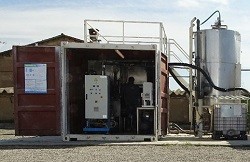Turning manure into gold
Approximately half the protein we eat comes from animal-based products. To feed our need for meat and dairy products, a considerable amount of manure is produced – about 1.27 billion tonnes from pigs and cows per year to be exact. To put this into perspective, this is enough manure to fill half a million Olympic-sized swimming pools. If not properly managed, this waste is harmful to the local environment and has a substantial impact on climate change. The manure problem is exacerbated by the fact it remains a largely unexploited resource of organic carbon and nutrients. This is because it is not economically feasible to transport manure from regions with a nutrient excess to those with a shortage. As a consequence, Europe’s agriculture sector remains heavily dependent on importing ‘fresh’ nutrients in the form of environmentally harmful synthetic fertilisers. The EU-funded MANUREECOMINE project aims to reverse this by using the resources present in manure in a refined and concentrated manner that also minimises emissions and environmental impact. ‘The project intends to demonstrate that a multi-modular technology can be flexibly applied to reduce the environmental impact of intensive animal husbandry in Europe,’ says Siegfried Vlaeminck, professor at Ghent University and the University of Antwerp. ‘What we propose is a sustainable answer to Europe’s nutrient challenge that is commercially appealing, brings value to farmers and enhances Europe’s resource autonomy.’ A green circle of manure To accomplish this, the project created a high-tech installation that recovers ‘green’ fertilisers from different types of manure. The process starts with a cow or pig creating manure, which is taken up by the MANUREECOMINE installation. The installation then refines various nutrients that can be used to re-blend into a bio-based, custom-made fertiliser. For example, one of the main products recovered is struvite, a precipitate of magnesium (Mg), ammonium (N), and phosphate (P), which can act as a slow-release fertiliser. Next, instead of turning environmentally harmful substances as fossil fuels and finite minerals into fertiliser, which is the case for making synthetic fertilisers, the project mixes the extracted nutrients with various sustainable additives. The result is a green fertiliser blend. ‘The project recovers different nutrients, which can be blended into different green fertilisers based on farmer needs and market demand,’ says Nico Boon, professor at Ghent University. ‘The green, completely European-made fertiliser is used in the field to grow feed crops, which are later fed to cows and pigs, who then create manure – thus creating a locally closed and completely sustainable cycle.’ A feasible market resource The MANUREECOMINE project is set to stimulate the market uptake of manure nutrient recovery technology. In fact, according to researchers, the estimated value of fertilisers present in European manure is around EUR 11 billion per year. For comparison purposes, European farmers currently pay EUR 15.5 billion per year for synthetic fertilisers. According to Vlaeminck, the main beneficiaries of the installation are designers, builders and operators of treatment plants; nutrient trader and fertiliser blending companies; and, primarily, farmers who choose to treat their manure locally. ‘Manure is no longer a waste product,’ concludes Vlaeminck. ‘With MANUREECOMINE, it is a resource that can be commercially mined for added value.’







